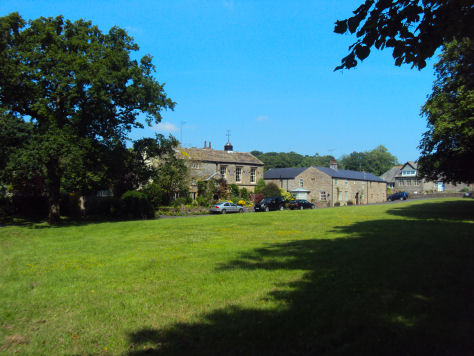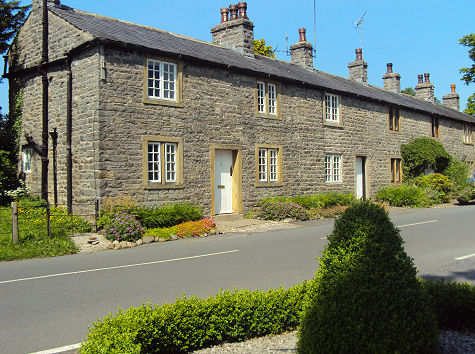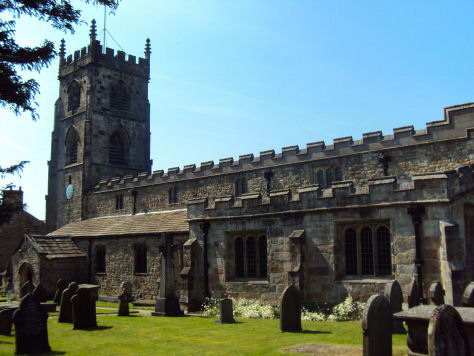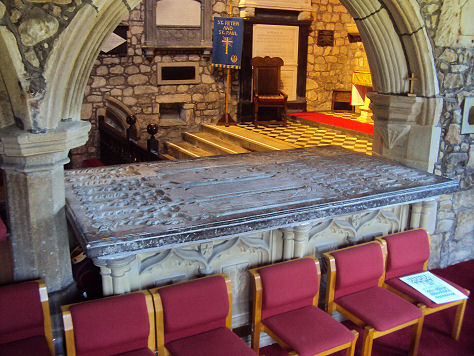Bolton by Bowland
OS Grid ref:- SD785495
The village of Bolton-by-Bowland is situated in Lancashire's scenic Ribble Valley.


The village is referred to as as Bodeton in the Domesday Book of 1086, which means bow in the river. The first recorded Bowbearer of the Forest of Bowland, Oughtred de Bolton, is said to have been lord of the manor in the late twelfth century.
Pleasantly situated on the Tosside Beck, near its confluence with the River Ribble, the village is a tranquil and charming settlement which boasts two village greens. The smaller green contains the remains of a stone cross dating from the thirteenth century and the old village stocks and is bordered by a memorial garden and overlooked by the Coach and Horses pub.
The church of St. Peter and st. Paul


The larger green is edged by trees on one side and on the other by a variety of characterful stone buildings, one of which as the Court House from the fifteenth to the nineteenth centuries.
Bolton Hall was the family seat of the Pudsay family from the fourteenth century until the family became extinct in 1771, when the last of the family, Bridget Pudsay, died without heirs.
 During the dynastic struggle for the crown now known as the Wars of the Roses, a turbulent time in the history of England, Henry VI, the last monarch of the House of Lancaster, hid at Bolton Hall. He stayed as the guest of Ralph Pudsey after fleeing from defeat at the hands of the rival Yorkist dynasty after the battle of Hexham in 1464. Legend states that during the year the king stayed at the hall, he discovered a natural spring by dowsing, the well is still remains on the Bolton Estate. On his departure Henry left behind a pair of boots, a pair of gloves and a spoon. The king was later sheltered by the Tempest family at Waddington Hall but was betrayed and captured by the Yorkists. Bolton Hall was demolished in the 1950s, the site is now occupied by a private development, called King Henry’s Mews, which is not open to the public, but the well can be seen from a public footpath near by.
During the dynastic struggle for the crown now known as the Wars of the Roses, a turbulent time in the history of England, Henry VI, the last monarch of the House of Lancaster, hid at Bolton Hall. He stayed as the guest of Ralph Pudsey after fleeing from defeat at the hands of the rival Yorkist dynasty after the battle of Hexham in 1464. Legend states that during the year the king stayed at the hall, he discovered a natural spring by dowsing, the well is still remains on the Bolton Estate. On his departure Henry left behind a pair of boots, a pair of gloves and a spoon. The king was later sheltered by the Tempest family at Waddington Hall but was betrayed and captured by the Yorkists. Bolton Hall was demolished in the 1950s, the site is now occupied by a private development, called King Henry’s Mews, which is not open to the public, but the well can be seen from a public footpath near by.
 The village church of St Peter and St Paul lies between the two greens, some of the fabric dates to the thirteenth century fabric, although most of the the building dates from the middle of the fifteenth century. A church has occupied the site from as early as 1190. The present church was built by Sir Ralph Pudsay, the Lord of the Manor of Bolton, it is claimed that Henry VI, then staying at Bolton Hall, influenced the design of the building. Ralph Pudsey's grandson, Henry Pudsay, added the chapel to the south of the chancel early in the sixteenth century.
The village church of St Peter and St Paul lies between the two greens, some of the fabric dates to the thirteenth century fabric, although most of the the building dates from the middle of the fifteenth century. A church has occupied the site from as early as 1190. The present church was built by Sir Ralph Pudsay, the Lord of the Manor of Bolton, it is claimed that Henry VI, then staying at Bolton Hall, influenced the design of the building. Ralph Pudsey's grandson, Henry Pudsay, added the chapel to the south of the chancel early in the sixteenth century.
The monument to Sir Ralph Pudsay (left), who died in 1468, is situated in the arch between the chancel and chapel. It is carved with the figures of Sir Ralph wearing full armour, along with his three wives, and his 25 children, with their names. The octagonal shaped sandstone font is early sixteenth century. Its bowl is carved with the coats of arms of prominent local families.including those of the Pudsay, Percy, Tempest and Hammerton families.
Rainsber Scar, which overlooks the River Ribble is known locally as Pudsay's leap, local legend relates that William Pudsay made the leap on horseback when being chased by the forces of the law for illegally minting coins, known as Pudsay shillings, the silver ore came from mines on his estate near Rimington. Pudsay was later pardoned by his godmother Elizabeth I.
There is a short walk downstream along Kirk Beck and then the River Ribble to the ruins of Sawley Abbey.
Nearby Places of Interest
Whalley Abbey- founded by Henry de Lacy, third Earl of Lincoln on the 4th April 1296.
Lancaster Castle founded in the tenth century
Ashton Memorial in Williamson Park, Lancaster was commissioned by James Williamson, Baron Ashton as a tribute to his second wife, Jenny and was built between 1907 and 1909.
Butterfly House, Lancaster
Clitheroe Castle-Norman castle keep and museum, said to be one of the oldest buildings in Lancashire, and one of the smallest keeps in England,
